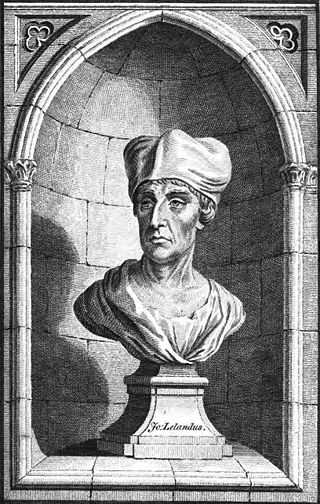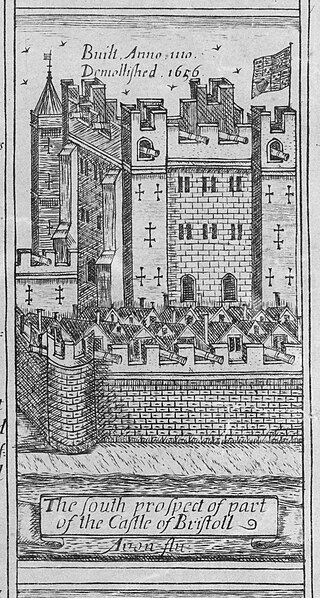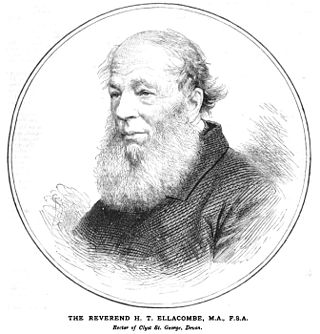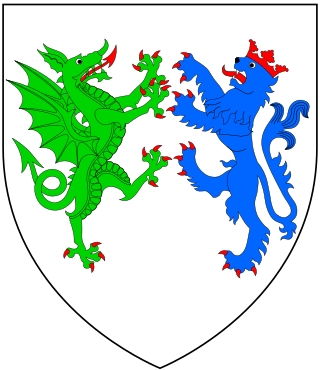Related Research Articles

John Leland or Leyland was an English poet and antiquary.

Thomas Hearne or Hearn was an English diarist and prolific antiquary, particularly remembered for his published editions of many medieval English chronicles and other important historical texts.

Richard Rawlinson FRS was an English clergyman and antiquarian collector of books and manuscripts, which he bequeathed to the Bodleian Library, Oxford.
Thomas William John Goddard was an English cricketer and the fifth-highest wicket taker in first-class cricket.

Bristol Castle was a Norman castle established in the late 11th century on the north bank of the River Avon in Bristol. Remains can be seen today in Castle Park near the Broadmead Shopping Centre, including the sally port.

Henry Thomas Ellacombe or Ellicombe (1790–1885), was an English divine and antiquary. He was the inventor of an apparatus to allow a single ringer to ring multiple bells.
English county histories, in other words historical and topographical works concerned with individual ancient counties of England, were produced by antiquarians from the late 16th century onwards. The content was variable: most focused on recording the ownership of estates and the descent of lordships of manors, thus the genealogies of county families, heraldry and other antiquarian material. In the introduction to one typical early work of this style, The Antiquities of Warwickshire published in 1656, the author William Dugdale writes:
I offer unto you my noble countriemen, as the most proper persons to whom it can be presented wherein you will see very much of your worthy ancestors, to whose memory I have erected it as a monumentall pillar and to shew in what honour they lived in those flourishing ages past. In this kind, or not much different, have divers persons in forrein parts very learnedly written; some whereof I have noted in my preface: and I could wish that there were more that would adventure in the like manner for the rest of the counties of this nation, considering how acceptable those are, which others have already performed

The Rev. Prebendary James Dallaway FSA was an English antiquary, topographer, and miscellaneous writer. He is known for his account of Constantinople and the Greek islands, published in 1797; and his county history of the western parts of Sussex, of which he published two volumes in 1815–19.
Samuel Rudder was a Gloucestershire topographer, printer and antiquarian who was born at Uley and baptised 5 December 1726. He was the son of Roger Rudder, a shopkeeper and pig-killer. Rudder ran a printing and bookselling business in Cirencester in the 1750s and wrote and published several works on the history of Gloucestershire.
John Collinson was an English cleric, antiquarian]and historian. He is best known for his three-volume history of Somerset which he published at the age of 34, two years before his death, and which earned him the title of "the Somerset historian".

John Tame of Cirencester and of Beauchamp Court in the parish of Fairford, both in Gloucestershire, England, was a wealthy wool producer and merchant who re-built the surviving St. Mary's Church, Fairford, the former structure of which had been built by one of the Beauchamp Earls of Warwick in the 15th century. The 28 Fairford stained glass windows he installed in the church are considered amongst the finest and most complete in England. He and his son Sir Edmund Tame (d.1534) so fostered the trade transacted at Fairford, that it came to rival that of the nearby long-established town of Cirencester, which increase was remarked upon by his contemporary the antiquary John Leland (d.1552): "Fairford never flourished afore the cumming of the Tames into it".

Thomas Fulljames FRIBA was an architect active in Gloucestershire, England, in the first half of the nineteenth century. As diocesan surveyor from 1832 until 1870, latterly in partnership with Frederick Sandham Waller, he designed, reconstructed or extended a number of churches in Gloucestershire.

George Worrall Counsel was a Gloucester solicitor, antiquarian, alderman, and property developer.
Abel Wantner or Wontner was an antiquary from Gloucester.
Irvine Egerton Gray MBE FSA was an antiquarian and archivist of Gloucestershire. He served in the British Army during the Second World War, rising to the rank of major in the Intelligence Corps, and after the war worked as records officer for Gloucestershire County Council. A member of the Bristol and Gloucestershire Archaeological Society, he was the author and editor of a number of works on the history of Gloucestershire.

Canon John Eric Gethyn-Jones MBE FSA was a clergyman and historian of Gloucestershire. He served in the Royal Army Chaplains' Department during the Second World War for which he was awarded the MBE in 1945. Later he was vicar of St Mary of the Virgin's Church, Berkeley, and rose to the position of Canon. He wrote a number of works including books on the history of Dymock and Berkeley, Gloucestershire.

This is a bibliography of the City of Gloucester in the south-west of England. The city lies close to the Welsh border, on the River Severn, between the Cotswolds to the east and the Forest of Dean to the southwest. It was founded by the Romans under Emperor Nerva as Colonia Glevum Nervensis, and was granted its first charter in 1155 by King Henry II.
Edward Pope was a Church of England minister.
Sydney Alfred Pitcher FRPS was a photographer with a special interest in medieval ecclesiastical architecture, particularly stained glass windows. In his 1926 book on English Stained Glass, the art historian and critic, Sir Herbert Read, acknowledged that the illustration of the book would have been difficult “without the co-operation of Mr Sydney Pitcher of Gloucester” to whom “all students of stained glass and of medieval art in general, are under a great debt for the enthusiastic zeal with which he is recording the remains of church art in England”.

Joan Cooke was the founder of The Crypt School in Gloucester following a bequest and request by her husband who died 17 years before her.
References
- 1 2 3 Gray, Irvine (1981). Antiquaries of Gloucestershire and Bristol. pp. 59–61.
- 1 2 "Alumni Oxonienses 1500-1714, Flooke-Fyrmin".
- 1 2 3 4 5 "Church of England Clergy Database".
- ↑ Horn, Joyce M. (1974), Fasti Ecclesiae Anglicanae 1541–1857, vol. 3, pp. 88–89
- ↑ "National Archives Discovery record summary".
- ↑ Remarks and Collections of Thomas Hearne. Oxford Historical Society. 1885. pp. 120, 215.
- ↑ Remarks and Collections of Thomas Hearne. pp. 213–4.